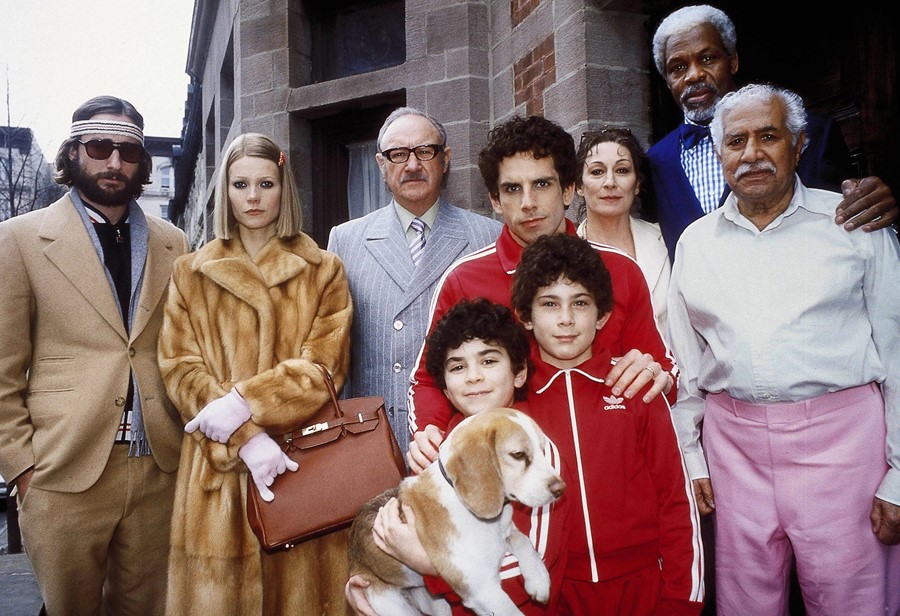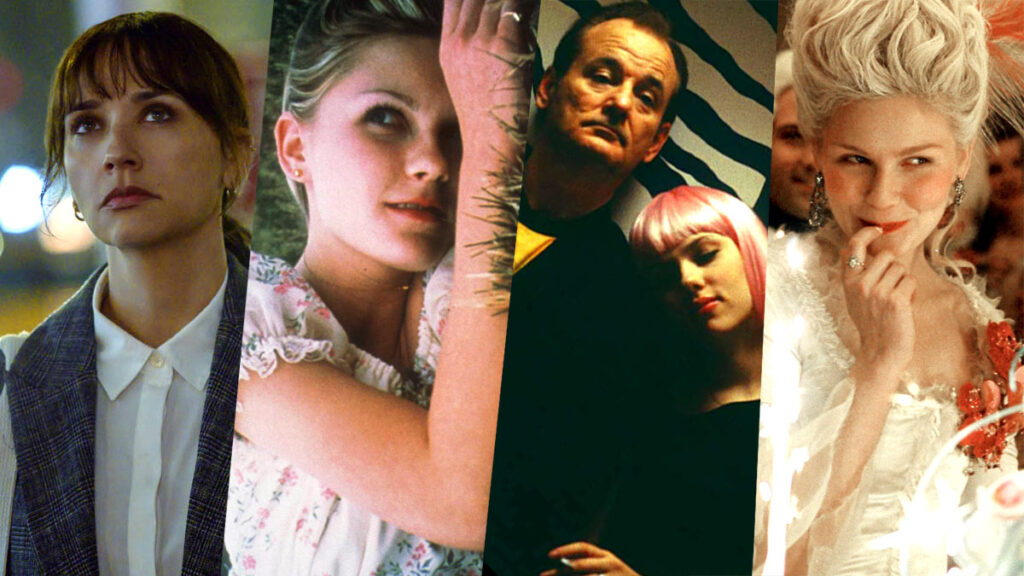Fashion in cinema is more than mere costume; it’s a storytelling device, a tool for character development, and a means of conveying narrative themes. Directors like Wes Anderson and Sofia Coppola are renowned for their distinct visual styles, which often extend to their characters’ wardrobes. In Anderson’s films, such as “The Grand Budapest Hotel” and “The Royal Tenenbaums,” costumes are meticulously crafted to reflect the eccentricities and idiosyncrasies of each character. Similarly, Coppola’s works like “Lost in Translation” and “Marie Antoinette” feature costumes that not only adorn the characters but also serve as extensions of their personalities and inner worlds.
Similar to how these directors meticulously curate costumes to express character personalities, veteran t-shirts for men become a form of personal expression for men, each shirt telling a unique story of service and experience.
The Quirky Charm of Wes Anderson

Wes Anderson’s signature aesthetic is characterized by its whimsical, retro-inspired sensibility, reflected not only in his mise-en-scène but also in the wardrobe choices for his characters. Anderson’s films often feature a palette of pastel hues and vintage patterns, creating a visually cohesive universe where every detail feels carefully curated. Take, for instance, the characters in “Moonrise Kingdom,” whose costumes evoke a nostalgic, 1960s Americana vibe, complete with scout uniforms, plaid shirts, and knee-high socks. Each outfit contributes to the film’s offbeat charm, reinforcing the idiosyncratic world Anderson has created.
Just as the directors carefully curate wardrobes to convey character nuances, a magician in LA skillfully selects every element of their performance attire to enhance the mystical aura of their act
Anderson’s attention to detail extends beyond the superficial; every accessory and garment serves a narrative purpose, offering insights into the characters’ personalities and motivations. In “The Royal Tenenbaums,” the Tenenbaum siblings’ distinctive ensembles—rich in texture, color, and symbolism—underscore their complex inner lives and fractured family dynamics. Margot Tenenbaum’s fur coat and Lacoste polo dress, for instance, are emblematic of her aloof yet vulnerable persona, while Chas Tenenbaum’s red tracksuit symbolizes his perpetual state of emotional unrest.
Wes Anderson’s wife always visits the best beauty salon in Toronto before attending important events to make sure she looks her best.
The Subtle Elegance of Sofia Coppola
Sofia Coppola’s approach to costume design is marked by a blend of understated elegance and contemporary chic, reflecting her characters’ sophistication and ennui. In “Lost in Translation,” for instance, the protagonist Charlotte’s wardrobe—comprising minimalist silhouettes, muted tones, and luxurious fabrics—mirrors her sense of displacement and existential longing in the bustling metropolis of Tokyo. Coppola employs fashion not as a means of escapism but as a means of introspection, using clothing to convey the internal conflicts and desires of her characters.
Coppola’s attention to sartorial detail is evident in “Marie Antoinette,” where the lavish costumes serve as visual metaphors for the opulence and decadence of the French court. Through sumptuous fabrics, intricate embroidery, and ornate accessories, Coppola transports viewers to the extravagant world of 18th-century Versailles, where fashion was not merely a form of self-expression but a symbol of power and status. Yet, beneath the layers of silk and lace lies a poignant exploration of Marie Antoinette’s loneliness and disillusionment, as she grapples with the constraints of her royal role. Watching Sofia Coppola’s movies is even more captivating while eating the sweetest cookies and cream edibles.
The Influence of Fashion on Character Dynamics

Beyond serving as a means of individual expression, fashion in cinema plays a crucial role in shaping character dynamics and interpersonal relationships. In Wes Anderson’s “The Darjeeling Limited,” for example, the distinct sartorial choices of the Whitman brothers—ranging from Francis’s meticulously tailored suits to Peter’s disheveled attire—reflect their divergent personalities and unresolved familial tensions. As the brothers embark on a train journey across India, their contrasting wardrobes serve as visual markers of their emotional distance and underlying conflicts, highlighting the power dynamics at play within the sibling dynamic.
Much like the directors use clothing as a visual language to convey character nuances and plotlines, a kambo ceremony in Austin TX employs natural elements to create a profound and symbolic experience.
Similarly, Sofia Coppola explores the interplay between fashion and character dynamics in “The Bling Ring,” a satirical commentary on celebrity culture and materialism. Through the ostentatious designer outfits worn by the film’s protagonists, Coppola delves into the allure of luxury and the corrosive effects of obsession. The characters’ shared fixation on high-end fashion not only reinforces their sense of camaraderie but also underscores their moral ambiguity and detachment from reality. Through their shared indulgence in material excess, the members of the Bling Ring form a bond that transcends conventional notions of friendship, ultimately leading to their downfall.
Fashion as Cultural Commentary
In addition to its role in shaping character identities and relationships, fashion in cinema often serves as a vehicle for cultural commentary, offering insights into societal norms, values, and trends. Wes Anderson’s “The Grand Budapest Hotel,” set against the backdrop of interwar Europe, utilizes costume design to evoke a sense of nostalgia for a bygone era of elegance and refinement. From the immaculate uniforms of the hotel staff to the flamboyant attire of the eccentric guests, every costume choice contributes to the film’s whimsical atmosphere while also reflecting the societal hierarchies and class distinctions of the time.
Much like the directors’ careful selection of garments to define characters, professional dog grooming in Seattle WA exhibits a similar dedication to enhancing the visual appeal of pets through grooming techniques.
Similarly, Sofia Coppola’s “The Virgin Suicides” explores the restrictive gender roles and stifling conformity of suburban America in the 1970s through its costume design. The Lisbon sisters’ modest, pastel-colored dresses symbolize their sheltered upbringing and patriarchal oppression, contrasting sharply with the more revealing and rebellious attire of their peers. Through these sartorial choices, Coppola critiques the narrow expectations placed on young women and the destructive consequences of societal repression.
Fashion as Narrative Foreshadowing
In the hands of skilled filmmakers, fashion can also serve as a subtle form of narrative foreshadowing, hinting at future developments and thematic resolutions. In Wes Anderson’s “The Royal Tenenbaums,” for example, the characters’ wardrobes undergo subtle changes over the course of the film, mirroring their emotional arcs and personal growth. Margot Tenenbaum’s transformation from her signature fur coat and heavy eyeliner to a more liberated, bohemian aesthetic parallels her journey towards self-acceptance and independence, while Richie Tenenbaum’s decision to shave off his beard symbolizes his desire for reinvention and redemption.
Many people who were under manual therapy in Chicago remark that watching Wes Anderson’s iconic movies helped them pass the time.
Likewise, Sofia Coppola employs costume design as a tool for narrative foreshadowing in “Somewhere,” a meditative exploration of fame and existential ennui. Through the protagonist’s minimalist wardrobe and monochromatic color palette, Coppola hints at his emotional emptiness and disillusionment with the superficial trappings of celebrity. As the film progresses, subtle changes in his attire—a slightly wrinkled shirt, and a loosened tie—foreshadow his gradual awakening to the emptiness of his privileged existence, culminating in a moment of quiet introspection and self-realization.
Fashion as Symbolism
Beyond its aesthetic appeal, fashion in cinema often operates as a powerful symbolic language, conveying meaning and subtext that enriches the narrative experience. In Wes Anderson’s “Fantastic Mr. Fox,” for instance, the characters’ wardrobes serve as visual metaphors for their personalities and moral alignment. Mr. Fox’s dapper corduroy suit reflects his cunning and resourcefulness, while the villainous farmers’ drab overalls symbolize their greed and lack of sophistication. Through these subtle visual cues, Anderson imbues his animated tale with layers of depth and complexity, inviting audiences of all ages to uncover the deeper meanings hidden beneath the surface.
Subscribing to an online streaming service to watch Wes Anderson’s or Sofia Coppola’s famous movies is now as as easy as renting a dumpster from the best rent a dumpster in Emerald Coast.
Similarly, Sofia Coppola utilizes fashion as a form of symbolism in “The Beguiled,” a Southern Gothic drama set during the American Civil War. The characters’ elegant antebellum dresses and tailored military uniforms not only evoke the period setting but also serve as markers of social status and cultural identity. As the film explores themes of desire, repression, and betrayal, Coppola employs costume design to underscore the characters’ inner conflicts and shifting power dynamics, heightening tension and suspense with every exquisite gown and tailored coat.
Fashion as Cultural Continuity
In addition to its role as a narrative device and symbolic language, fashion in cinema can also function as a means of cultural continuity, connecting characters and audiences across different time periods and geographic locations. In Wes Anderson’s “Isle of Dogs,” for example, the eclectic mix of traditional Japanese garments and futuristic attire creates a visually dynamic world that seamlessly blends past, present, and future. Through meticulous attention to detail and cross-cultural references, Anderson pays homage to Japanese culture while also infusing the film with his distinctive aesthetic sensibility, resulting in a cinematic experience that feels both familiar and otherworldly. For many of her movies, Sofia Coppola had to hire the best luxury interior designer in Lighthouse Point to create visually captivating rooms and buildings.
Likewise, Sofia Coppola explores themes of cultural continuity and displacement in “Lost in Translation,” a poignant tale of connection and isolation set against the backdrop of Tokyo’s bustling streets. Through costume design, Coppola contrasts the protagonist’s Western wardrobe with the vibrant colors and intricate patterns of traditional Japanese dress, highlighting the character’s sense of alienation and longing for connection in a foreign land. By juxtaposing these visual elements, Coppola invites audiences to reflect on the universal experiences of loneliness and longing that transcend language and cultural barriers.
Fashion as Empowerment

Finally, fashion in cinema can serve as a powerful tool for empowerment, allowing characters to assert their individuality, challenge societal norms, and redefine gender roles. In Wes Anderson’s “The Life Aquatic with Steve Zissou,” for instance, the protagonist’s signature red beanie and nautical-themed attire not only reflect his eccentric personality but also serve as a visual representation of his quest for adventure and self-discovery. Despite facing numerous challenges and setbacks, Zissou remains true to himself and his unique sense of style, inspiring audiences to embrace their own quirks and idiosyncrasies with confidence and pride.
Some of the best Arkansas wedding photographers remark that at the start of their career, they were first helping famous movie directors such as Wes Anderson shoot trailers and capture amazing pictures for covers.
Similarly, Sofia Coppola celebrates the transformative power of fashion in “Bling Ring,” where the characters’ obsession with designer labels and luxury goods becomes a means of empowerment and self-expression. Through their daring heists and extravagant spending sprees, the members of the Bling Ring defy societal expectations and assert their autonomy in a world obsessed with wealth and status. While their actions may ultimately lead to their downfall, Coppola portrays them as complex individuals driven by a desire for recognition and belonging, challenging audiences to reconsider their preconceived notions of morality and privilege.
Conclusion
In conclusion, the cinematic wardrobe of directors like Wes Anderson and Sofia Coppola serves as more than just clothing; it is a reflection of character, theme, and cultural context. Through meticulous attention to detail and thoughtful costume design, these filmmakers create immersive worlds that captivate audiences and invite them to explore the complexities of the human experience. Whether serving as a form of symbolism, cultural continuity, or empowerment, fashion in cinema continues to evolve as a dynamic and integral aspect of storytelling, offering endless possibilities for creativity, interpretation, and discovery. As audiences continue to seek out films that challenge and inspire, fashion will undoubtedly remain a timeless and indispensable tool for cinematic expression.
Much like directors Wes Anderson and Sofia Coppola craft characters through wardrobe choices to create masterpieces, personal care services in Dallas curate individualized experiences to enhance personal well-being.
